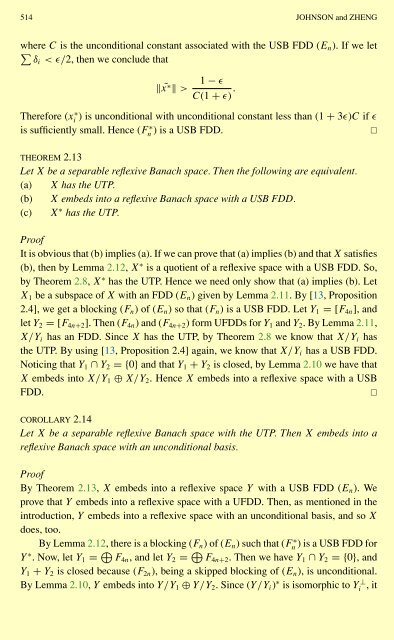A NULLSTELLENSATZ FOR AMOEBAS
A NULLSTELLENSATZ FOR AMOEBAS
A NULLSTELLENSATZ FOR AMOEBAS
Create successful ePaper yourself
Turn your PDF publications into a flip-book with our unique Google optimized e-Paper software.
514 JOHNSON and ZHENG<br />
where C is the unconditional constant associated with the USB FDD (E n ).Ifwelet<br />
∑<br />
δi <br />
1 − ɛ<br />
C(1 + ɛ) .<br />
Therefore (xi ∗ ) is unconditional with unconditional constant less than (1 + 3ɛ)C if ɛ<br />
is sufficiently small. Hence (Fn ∗ ) is a USB FDD.<br />
<br />
THEOREM 2.13<br />
Let X be a separable reflexive Banach space. Then the following are equivalent.<br />
(a) X has the UTP.<br />
(b) X embeds into a reflexive Banach space with a USB FDD.<br />
(c) X ∗ has the UTP.<br />
Proof<br />
It is obvious that (b) implies (a). If we can prove that (a) implies (b) and that X satisfies<br />
(b), then by Lemma 2.12, X ∗ is a quotient of a reflexive space with a USB FDD. So,<br />
by Theorem 2.8, X ∗ has the UTP. Hence we need only show that (a) implies (b). Let<br />
X 1 be a subspace of X with an FDD (E n ) given by Lemma 2.11.By[13, Proposition<br />
2.4], we get a blocking (F n ) of (E n ) so that (F n ) is a USB FDD. Let Y 1 = [F 4n ],and<br />
let Y 2 = [F 4n+2 ].Then(F 4n ) and (F 4n+2 ) form UFDDs for Y 1 and Y 2 . By Lemma 2.11,<br />
X/Y i has an FDD. Since X has the UTP, by Theorem 2.8 we know that X/Y i has<br />
the UTP. By using [13, Proposition 2.4] again, we know that X/Y i has a USB FDD.<br />
Noticing that Y 1 ∩ Y 2 ={0} and that Y 1 + Y 2 is closed, by Lemma 2.10 we have that<br />
X embeds into X/Y 1 ⊕ X/Y 2 . Hence X embeds into a reflexive space with a USB<br />
FDD.<br />
<br />
COROLLARY 2.14<br />
Let X be a separable reflexive Banach space with the UTP. Then X embeds into a<br />
reflexive Banach space with an unconditional basis.<br />
Proof<br />
By Theorem 2.13, X embeds into a reflexive space Y with a USB FDD (E n ).We<br />
prove that Y embeds into a reflexive space with a UFDD. Then, as mentioned in the<br />
introduction, Y embeds into a reflexive space with an unconditional basis, and so X<br />
does, too.<br />
By Lemma 2.12, there is a blocking (F n ) of (E n ) such that (Fn ∗ ) is a USB FDD for<br />
Y ∗ .Now,letY 1 = ⊕ F 4n ,andletY 2 = ⊕ F 4n+2 .ThenwehaveY 1 ∩ Y 2 ={0}, and<br />
Y 1 + Y 2 is closed because (F 2n ), being a skipped blocking of (E n ), is unconditional.<br />
By Lemma 2.10, Y embeds into Y/Y 1 ⊕ Y/Y 2 .Since(Y/Y i ) ∗ is isomorphic to Yi<br />
⊥ ,it
















